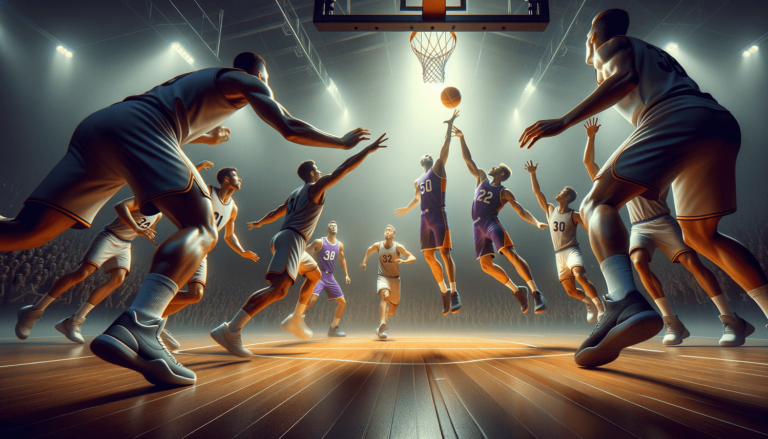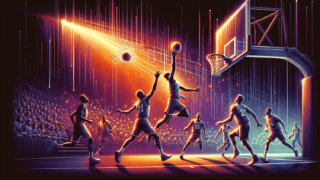
Have you ever found yourself watching an electrifying basketball game, only to wonder what on earth is going on when the players suddenly leap to send the ball back into the hoop after a missed shot? If so, you’ve stumbled upon the thrilling action known as the tip-in! In this blog post, we’ll dive into the ins and outs of this remarkable play, unraveling the different styles and techniques, and exploring how it can elevate a team’s game to new heights. So, whether you’re a die-hard hoops fan or a newcomer to the sport, hold on tight as we take you on a tip-in adventure you won’t want to miss!
What’s a Tip-In in Basketball?
A tip-in in basketball is an offensive play where a player gently taps the ball, which is either mid-air or on the rim, into the hoop to score points. It often occurs after a missed shot, with the player using their quick reflexes, timing, and jumping ability to direct the ball back into the basket before it touches the floor or another player gains possession.
Mastering the Art of Tip-Ins
Although the concept of a tip-in may seem simple, there’s much more to it than just tapping the ball into the hoop. To truly understand the intricacies and develop the skills necessary to excel at tip-ins, it’s helpful to break down the various components that contribute to a successful execution. So, let’s dive right in and explore the world of tip-ins in the exhilarating sport of basketball!
The Importance of Timing
When it comes to sinking a tip-in, timing is everything. Performing at just the right moment can mean the difference between scoring and losing possession. The key is to anticipate when and where the ball will bounce off the rim and act at the perfect instant to redirect it into the basket.
Practice Makes Perfect
Mastering the timing of a tip-in takes practice and dedication, as players need to learn how to read the trajectory of a missed shot accurately. Through repetitive drills and game experience, a player can refine their ability to anticipate where the ball will land, increasing their chances of success.
Height and Vertical Leap
It’s no secret that height and jumping ability play a significant role in pulling off an impressive tip-in. Taller players, who can reach greater heights, have an inherent advantage when attempting to tip the ball back into the hoop, as they can often out-reach the defenders.
Developing Your Jump
While not everyone is blessed with immense height, improving your vertical leap can greatly increase your potential for executing successful tip-ins. Incorporating plyometric exercises and dedicated jump training into your workout routine will not only help you reach new heights but can also enhance your overall athleticism and explosiveness on the court.
Proper Positioning
Securing a strong position near the basket is crucial for capitalizing on tip-in opportunities. Oftentimes, this requires the agility and determination to fight for the optimal spot while avoiding or fighting off defenders.
Boxing Out
Boxing out is a technique used by rebounders to shield an opponent from getting close to the basket, creating the necessary space to pursue a missed shot. By practicing this essential skill, offensive players can increase their chances of converting a tip-in and securing valuable extra points for their team.
Varieties of Tip-Ins
The beauty of the tip-in lies in its versatility. There are several different ways a basketball player can execute this captivating move, each adding its own unique flair to the game. Let’s explore some of the more renowned types of tip-ins and the legendary players who made them famous.
One-Handed Tip-In
As the name suggests, a one-handed tip-in involves using a single hand, typically the player’s dominant hand, to tap the ball back into the hoop. This method demands considerable dexterity and strength, as one hand must generate sufficient force to propel the ball while maintaining control. Players like Charles Barkley and Moses Malone were skilled at this type of tip-in, making it one of the more commonly used methods in basketball.
Two-Handed Tip-In
For players seeking more control and stability, the two-handed tip-in may be the preferred choice. By using both hands to direct the ball, this method allows for greater accuracy and a softer touch. Basketball legends such as Bill Russell and Wilt Chamberlain frequently employed the two-handed tip-in, utilizing their height and leaping ability to excel at this technique.
Slam Tip-In
Arguably the most exhilarating variety is the slam tip-in, wherein a player channels their inner power and forcefully tips the ball into the hoop with a dunk-like motion. This style is particularly popular among high-flying players like LeBron James and Blake Griffin, whose sheer athleticism and finesse electrify the court and leave fans in awe.
Defensive Strategies Against Tip-Ins
A well-executed tip-in not only boosts a team’s offensive prowess, but it can also demoralize the opposition. That’s why developing effective defensive strategies to prevent tip-ins is vital for any successful basketball team. Let’s take a look at some tactics teams can employ to shut down tip-in opportunities and keep the competition at bay.
Emphasizing Box-Outs
As mentioned earlier, boxing out is crucial for rebounding, and its importance is equally vital when it comes to denying tip-in attempts. By focusing on properly boxing out opponents, defenders can prevent offensive players from getting into prime tip-in positions, forcing them to work harder for scoring opportunities.
Anticipating Shot Trajectories
Just as offensive players need to read and anticipate missed shot trajectories, so too must defensive players. By understanding where the ball is likely to bounce and positioning themselves accordingly, defenders can increase their chances of gaining possession and minimizing tip-in opportunities for the opposition.
Team Communication
Communication is the cornerstone of any successful team, and it’s no different when it comes to defending against tip-ins. Alerting teammates to potential tip-in threats and sharing information about the positioning of opposing players can help a team coordinate its defense and reduce the likelihood of successful tip-in attempts.
Taking Advantage of Tip-In Opportunities
Now that we’ve delved into the mechanics, strategies, and varieties of tip-ins, it’s time to put that knowledge to good use. Below, we offer some advice to incorporate tip-ins into your team’s offensive arsenal and take the opposition by surprise.
Targeting Mismatches
Capitalizing on mismatches, such as a height advantage or quicker reflexes, can make a significant impact in executing tip-ins. Encourage players to recognize and exploit these mismatches on the court, and leverage them to create opportunities for tip-ins and putbacks.
Offensive Rebounding Drills
Integrating specific drills that emphasize offensive rebounding and tip-ins into team practices can help players develop the necessary skills and instincts required for success. These drills should focus on timing, jumping, and positioning, as well as ball control and finesse.
Transitioning to Tip-Ins
Teaching players to view missed shots as potential tip-in opportunities can greatly enhance a team’s offensive firepower. By emphasizing and ingraining a tip-in mindset, coaches can help their players quickly transition to offensive rebounds and tip-ins as opportunities arise in the heat of the game.
Conclusion
While the tip-in may not be the most glamorous or flashy aspect of basketball, it’s an integral part of the sport that can greatly impact the outcome of a game. With diligent practice, a thorough understanding of the intricacies of the play, and the right mindset, players and teams can reap the benefits this deceptively complex move offers, and elevate their game to new heights.
The Role of Tip-Ins in Basketball Strategy
Tip-ins may be a singular aspect of the game, but they play a valuable role in a team’s overall basketball strategy. In this section, we’ll explore how tip-ins can impact scoring, momentum, and opportunities for teams on the offensive.
Boosting Scoring Efficiency
The ability to convert tip-ins effectively grants teams an opportunity to salvage otherwise missed points. By doing so, they increase their overall scoring efficiency and can potentially cause opponents to question their defensive tactics. Players who excel at tip-ins often have a heightened offensive presence and can contribute significantly to their team’s success.
Building Momentum
Successfully landing a tip-in not only results in additional points but can also serve as a momentum booster. Executing a well-timed, stylish tip-in can energize teammates and even sway the trajectory of a game. This is especially important in moments when a scoring run is needed or during high-pressure situations, like the closing minutes of a tightly contested match.
Forcing Defensive Adjustments
A team known for its prowess in pulling off tip-ins can force their opponents to adjust their defensive strategies. By doing so, they can potentially create openings on the perimeter or greater opportunities for drives, benefiting other offensive players. Exploiting this skill can become a strategic element in managing games and keeping opponents on their toes.
Legendary Tip-Ins in Basketball History
In addition to the awe they evoke, some tip-ins have also carved their place in basketball history due to their significance and impact on the outcome of important games. In this section, we celebrate a few of the most memorable tip-ins that have left an indelible mark on basketball lore.
Michael Jordan’s Game-Winning Tip-In
In 1989, during Game 5 of the first round of the NBA playoffs, Michael Jordan added a thrilling tip-in to his already stellar list of career highlights. With only seconds remaining and against the seemingly impenetrable defense of the Cleveland Cavaliers, Jordan tapped in the game-winning shot to seal a 3-2 series victory for the Chicago Bulls.
Patrick Ewing’s Fierce Tip-In Dunk
In a 1993 Eastern Conference Semifinals game between the New York Knicks and Charlotte Hornets, Patrick Ewing showcased his incredible athleticism with an unforgettable tip-in dunk. Ewing sprang into action and slammed the ball off the glass, serving as a crucial play in a hotly contested matchup that ultimately led to the Knicks’ victory.
Tyus Edney’s Pivotal Tip-In
In the 1995 NCAA Tournament, the UCLA Bruins and Missouri Tigers engaged in an intense battle that saw multiple lead changes. With only 4.8 seconds remaining on the clock, UCLA’s Tyus Edney raced down the court for a layup, only for it to be blocked by Missouri. Despite the defensive pressure, Edney recovered quickly and tapped in his own rebound, sealing a memorable victory for the Bruins and propelling them to the next round of the tournament.
Famous Tip-In Artists in Basketball History
Some players have made a name for themselves in the basketball world and etched their place in history as masters of the tip-in craft. It’s only fitting that we recognize these extraordinary athletes and acknowledge their incredible impact on the game of basketball.
Moses Malone
Often referred to as the godfather of tip-ins, Moses Malone’s supreme instincts and relentless pursuit of rebounds made him the bane of defenders throughout his lengthy career. Malone, a three-time MVP and Hall of Famer, had an uncanny ability to secure offensive rebounds and convert them into valuable points, frequently with expertly executed tip-ins.
Dennis Rodman
Dennis Rodman’s unique combination of raw athleticism, aggressiveness, and unyielding determination made him one of the most effective rebounders in basketball history. Rodman, a Hall of Famer and five-time NBA champion, was notorious for his ability to anticipate missed shots, grabbing an astounding number of rebounds and impressively converting them through well-timed tip-ins.
Charles Barkley
Despite being an undersized power forward at only 6’6″, Charles Barkley’s tenacity, strength, and leaping ability earned him a well-deserved spot among the greats of the tip-in craft. “The Round Mound of Rebound” captured attention with his relentless work on the offensive glass and an uncanny knack for converting difficult tip-ins.
FAQ – Tip-Ins in Basketball
Still curious about tip-ins in basketball? Check out the answers to some of the most frequently asked questions regarding this fascinating aspect of the game. Whether you’re a seasoned basketball enthusiast or a newcomer, this FAQ section is here to further your understanding and knowledge of tip-ins.
1. How many points is a tip-in worth?
A tip-in is worth the same number of points as a regular field goal, either two or three points. The point value depends on whether the tip-in occurs within or beyond the three-point arc.
2. Can a defensive player execute a tip-in?
While tip-ins are typically associated with offensive plays, a defensive player can inadvertently execute a “tip-in” when trying to prevent an opponent’s shot or rebound. In this case, it is referred to as goaltending and results in points being awarded to the offensive team.
3. Is tipping the ball back into the hoop after a missed free throw considered a tip-in?
Yes, tipping the ball back into the hoop after a missed free throw is considered a tip-in. Players often attempt this play to capitalize on missed free throw opportunities and secure extra points for their team.
4. Can a player tip-in the ball while still on the ground?
Although uncommon, it is technically possible for a player to execute a tip-in while still on the ground by tapping the ball into the hoop after a missed shot. However, this scenario is rare as most tip-ins involve jumping and outreaching defenders.
5. Is there a difference between a tip-in and a putback?
A tip-in and a putback are closely related but not exactly the same. A tip-in refers to the act of tapping the ball into the hoop with one or both hands, while a putback is a slightly broader term that includes any offensive rebound followed immediately by a scoring attempt, including layups or dunks.
6. Are tip-ins only possible after a missed shot?
Tip-ins are most commonly executed following missed shots, as this provides the most opportunities for players to anticipate and react to rebound trajectories. However, tip-ins can also occur after a teammate’s intentional pass or an airball that does not touch the rim or backboard.
7. How is a tip-off different from a tip-in?
A tip-off refers to the initial jump ball at the beginning of a basketball game, when a referee tosses the ball into the air, and the two opposing teams’ centers jump to tip the ball to their teammates. In contrast, a tip-in is the act of tapping a mid-air ball into the hoop to score points after a missed shot.
8. Is there a rule against goaltending for offensive players during tip-ins?
Offensive goaltending occurs when an offensive player interferes with the ball while it is on its downward trajectory towards the hoop or is in contact with the rim. In these cases, the basket is disallowed, and the possession is awarded to the opposing team. Therefore, players attempting tip-ins must be wary of committing an offensive goaltending violation.
9. How can a player become better at executing tip-ins?
To become better at executing tip-ins, players should focus on improving their timing, vertical leap, positioning, and strength. Practicing rebounding drills, anticipating missed shot trajectories, boxing out, and refining their overall athleticism will help enhance their tip-in abilities.
10. How can a defender avoid letting their opponent score a tip-in?
Defenders can prevent opponents from scoring tip-ins by focusing on proper boxing-out technique, anticipating shot trajectories, improving their vertical leap, and communicating with their teammates to coordinate a solid defensive strategy.
Featured Posts
- No pillar pages found.





